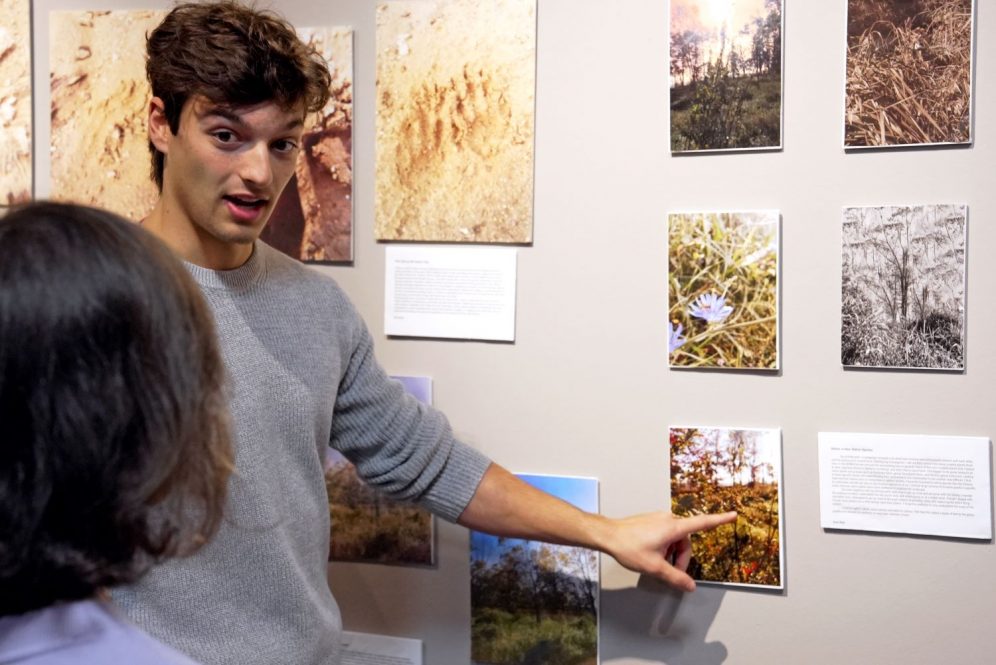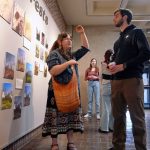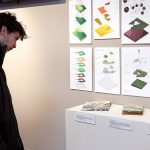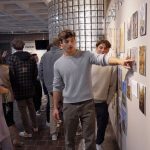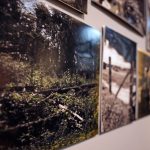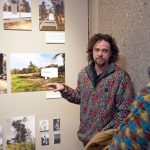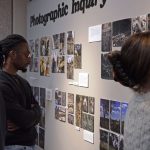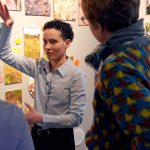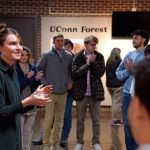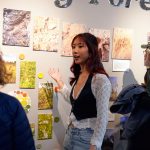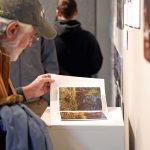The Storrs campus is always evolving, yet some changes are not easy to see. A class in the Landscape Architecture program in the College of Agriculture, Health and Natural Resources is making the transformation of a portion of the UConn Forest more visible in an engaging exhibit currently showing in the Homer Babbidge Library. Through creative displays incorporating photographs, 3-D models, and animation, students are exploring the past, present, and future of a parcel of land adjacent to Horsebarn Hill.
The exhibit, entitled Visualizing Forests, is the work of students in Graphics III (LAND 3130), a computer course offered by the Department of Plant Science and Landscape Architecture. This past fall assistant professor Julia Smachylo asked students to consider forests as socio-ecological systems, and investigate the complex relationships between the environment and human activity, including their maintenance and care as part of UConn’s campus. She selected a 40-acre parcel of the Fenton Tract along Horsebarn Hill Road as the focus of their study after talking with Tom Worthley, associate extension professor of forest sustainability with UConn Extension and students in the Department of Natural Resources and the Environment.
“It’s a site experiencing rapid change,” says Smachylo. “Our class explored these changes along a spectrum of intervention, where various forms of human action are attenuating the impacts from invasive species and furthering opportunities for stewardship that facilitate native plantings, enhance biodiversity, and improve habitat quality, aesthetics and recreation.”
Worthley and his team of students are currently working on controlling invasives, laying out an area for an American chestnut germplasm orchard, processing sawlogs for timbers to build a pavilion, and making access improvements to this area. This area of the UConn Forest once held many ash trees, but the arrival of the emerald ash borer in 2017 caused a quick and sharp decline of the species. Worthley and the students are working to re-purpose the site, using salvaged wood from the ash trees to build an outdoor classroom. There are other long-term management goals, including planting a chestnut orchard and enhancing the existing trail system.
“The site provided an exciting opportunity for students to investigate and explore the UConn Forest as it undergoes these changes and then to share their ways of seeing it in an exhibit format, allowing for their individual work to be seen and understood alongside their peers.”
Smachylo wanted students’ work to be displayed in a high-traffic and accessible space, so she reached out to Jean Cardinale, head of communication and marketing for the UConn Library. Together, they found the Norman D. Stevens gallery in the Babbidge Library an ideal setting. Kim McNamara, technology strategist for the UConn Library, also provided much-needed support.
“Jean was very supportive of the project and I appreciate how easy she made the process,” says Smachylo. “And Kim has been instrumental in providing technology for my students throughout the semester as we used the Maker Studio for the development of the students’ physical models and for elements of the exhibition.”
The exhibit opened in December, marking the culmination of a semester of work with students presenting and discussing their projects.
“I had an amazing experience with the project, presentation, and exhibition,” says Haley Vitko ‘25 (CAHNR). Her project, Fenton Forest Life Cycles, was a photographic inquiry into perennial flora using a large triptych format to present different plant’s changes from summer to fall.
“I really enjoyed being a part of the exhibition, not only to present my own work, but to see the work of my classmates come together as well. It was exciting to see all of our work displayed together to create a showcase of the artwork and visualization we were capable of,” says Vitko.
“The exhibition format of the final phase of the project worked so well because each student was presenting an idea that they worked on all semester and had grown passionate about,” says Seth Canaday ‘25 (CAHNR).
“We’ve spent a lot of late nights in the studio working on projects. There’s a strong sense of comradery in the major. Everyone wants the best for one another. There’s a lot of collaboration and communication going on, sharing ideas, and helping each other out. It’s an environment that is conducive to improving and which cultivates a sense of passion,” says Canaday.
Visualizing Forests is currently on display in the Norman D. Stevens gallery in the Homer Babbidge Library. It is expected to be on display through February.
This work relates to the UConn’s College of Agriculture, Health and Natural Resources Strategic Vision area focused on Fostering Sustainable Landscapes at the Urban-Rural Interface.
Follow UConn CAHNR on social media
